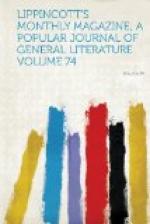We had been resting during Joergel’s narration: the long rays of the declining sun now warned us to hasten on. Margaret, full of energy and desirous of pushing forward up the almost vertical path, soon began to lag behind. Thus I, looking back and waiting for her, saw a comely peasant-woman who, quickly climbing the hill behind, offered her the assistance of her arm. Although this was gratefully declined, the stranger, apparently troubled at the sight of the tired lady, tarried at her side, trying to be of service. She had a melodious voice and a restful air, which made us, though she was but a poor illiterate woman, feel better for her presence. Thus she was allowed to carry our shawls, and whenever we rested she strayed into wayside glens, returning with offerings of mellow bilberries; and finally she cheered our lagging energies with the assurance that we should soon see blue sky peeping through the trees, and that then there would be no more climbing. At this point, Joergel, who had been carefully examining each tree as we passed, expressed his fear that no actual hazel-fir tree grew along this path. He, however, pointed out a well grown fir tree, saying that a hazelfichte merely possessed a straighter and a smoother stem.
We had begun truly to descend, and our friendly woman, seeing that “Shank’s mare” required no further encouragement, bade us a friendly good-evening, with a cheerful “May you live long and well!” She had almost dipped out of sight when our Joergel, with praiseworthy forethought, called after her to apprise the bath people, as she passed, of our advent.
The path had become broader and more beaten. There was a gradual sense of some human being, either from personal or unselfish interests, having once been at work to make the woods still more attractive and enjoyable. Benches of flat stones were raised at points where snow-fields, fantastic and stern dolomite peaks and wooded slopes formed exquisite pictures set in frames of stately, well-grown fir trees—here a smooth lawn with its little shrine and wooden seat for the wayfarer to meditate on the Flight into Egypt, which Joergel called the “witches’ ground;” there, under a spreading tree, a rural table and seats—proofs that we must be approaching the bath-house; and no little were we pleased by these signs of care and judgment, especially as none of the rural bowers were either bran-new or in a state of decay, but harmonizing with the tidy negligence of the woods themselves.
“These paths promise well for the baths,” we remarked to Joergel.
“Might have done so once,” he replied, “but it was the old Frau Wirthin who put them up. She was a woman with a head and a will, and she took a pride in the place, seeing that the baths are as old as the mountains, and they had been in her family since the Lord made the Tyrol. Now they are in the hands of her son Seppl and his sister Moidel. However, I never mix myself up in what




